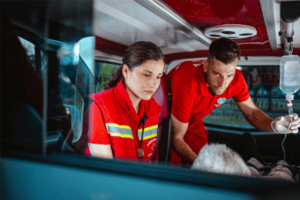Emergency response times across Nova Scotia, which had risen steadily in recent years, are improving, says the head of the province’s ambulance service.
Average response times are down from 36 minutes to 18 minutes provincewide so far this year, Matthew Crossman, president of Emergency Medical Care Inc., told the legislature’s public accounts committee Wednesday.
Crossman attributed the improvement to the use of an air ambulance for long-distance transfers to Halifax hospitals, which has liberated ground crews for shorter trips. Improved wait times are also due to clinical programs, including one that allows paramedics to discharge some patients at the scene of their treatment without having to bring them to hospital, he added.
Under that program, paramedics are able to consult with physicians and nurses at the ambulance communications centre to determine the severity of any injuries before determining options.
“About a third of our calls result in non-transport, which allows us to be able to get to [other] people quicker,” Crossman told the committee. He said the use of the aircraft has added 11,500 service hours back to the ground ambulance system.AD
AG report found wait times were up
Last September, provincial auditor general Kim Adair released a report showing the average wait time for an ambulance in 2022 had risen to 25 minutes from 14 minutes. Between 2017 and 2022, average response times had grown between two and five per cent annually.
Adair also found that in 2022, paramedics were on average spending one-quarter of their working hours in emergency department hallways waiting for patients to be admitted to hospital, a process known as patient transfers. That year, none of the province’s largest hospitals consistently met the province’s transfer standard of 30 minutes, with her audit finding that standard was met only 23 per cent of the time.
The committee was told that so far this year, over 30 per cent of patient transfers are occurring at the 30-minute mark. Still, patient transfer times remain high, ranging anywhere from 90 minutes to two hours.
Crossman told reporters that he believes patient volumes are at the heart of the problem with the ambulance service now handling about 200,000 calls a year from across the province. “The hospital is also seeing the same amount of patients going in so it’s about finding innovative ways to care for people,” he said.
Karen Oldfield, interim CEO of the province’s health authority, said the current hospital occupancy rate is 104 per cent, which ends up clogging the system as patients try to access care.
Oldfield said a provincewide command centre that provides information on bed availability and patient transfers has helped with system access, as have various clinical teams that assess the level of treatment required by patients at hospital emergency departments.
As for patient transfer times by ambulances, she said there’s still room for improvement.
“Incrementally … it’s a classic case of how do you eat an elephant? One bite at a time,” Oldfield said.
Your Next Step is the go-to resource for all inquiries and retirement needs. We are the best Canadian website that offers a wide array of services to support nearly every next step for your retirement.
The words that help us Grow!
elderly care, senior care, care homes Canada, retirement homes, assisted living, senior living, nursing homes, elder support services, long-term care facilities, senior housing, retirement communities, dementia care, Alzheimer’s care, senior healthcare Canada, geriatric care, elderly care services, home care for seniors, respite care, senior wellness, aging in place, seniors home care, palliative care for elderly, independent living for seniors, senior citizen care Canada, senior support Canada, senior housing options Canada, nursing homes, long-term care, skilled nursing facility, elderly care, senior care, nursing care, residential care, senior living, senior healthcare, geriatric care, assisted living, dementia care, Alzheimer’s care,24-hour care, palliative care, respite care, retirement homes, senior housing, senior support services, care facilities, senior rehabilitation, nursing home services, aging care, senior wellness programs, healthcare for seniors, long-term care facility, subsidized housing, affordable housing, low-income housing, housing assistance, rental assistance, government housing, housing subsidy, public housing, income-based housing, affordable rental units, social housing, housing support programs, rent-geared-to-income, affordable apartments, housing benefits, low-cost housing, non-profit housing, housing for seniors, community housing, affordable living, housing affordability, subsidized rental programs, housing grants, nursing, nursing profession, registered nurse, RN, licensed practical nurse, LPN, healthcare, nursing care, patient care, nursing education, nurse practitioner, clinical nursing, nursing services, nursing jobs, nurse training, healthcare professionals, nursing skills, nursing careers, medical nursing, nursing assistants, home healthcare nurse, nursing degrees, nursing certifications, nurse responsibilities, nursing specialties nursing ethics, hospital nursing, homecare, in-home care, home healthcare, home care services, senior homecare, elderly care at home, home nursing, personal care services, home health aides, caregiver services, respite care, home support services, palliative homecare, home medical care, home assistance for seniors, live-in care, homecare providers, domiciliary care, healthcare at home, home therapy services, companion care,24-hour homecare, home health support, homecare for disabled, in-home nursing care, disability, disability services, disability support, physical disability, intellectual disability, disability benefits, special needs, disabled individuals, disability rights, accessible living, disability care, disability, assistance, inclusive education, mobility aids, mental health disability, disability advocacy, disability, accommodations, disability insurance, disability inclusion, accessible housing, disability employment, disability awareness, assistive technology, disability rehabilitation, independent living, disability resources, Canada, Canadian provinces, provinces of Canada, Ontario, Quebec, British Columbia, Alberta, Manitoba, Saskatchewan, Nova Scotia, New Brunswick, Prince Edward Island, Newfoundland and Labrador, Northwest Territories, Yukon, Nunavut, Canadian geography, Canadian regions, Canadian territories, Canadian government, Canada travel, Canada tourism, Canadian culture, Eastern Canada, Western Canada, Atlantic Canada, Northern Canada, Canadian cities, Canadian economy, Canadian provinces map
